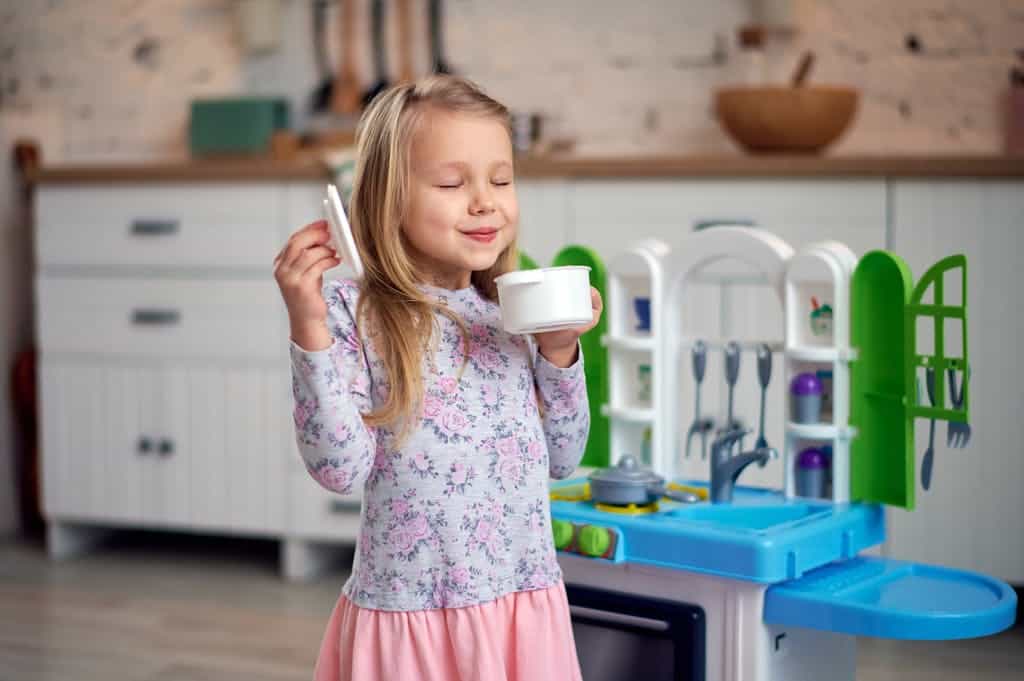Learning Through Play: How Play Fuels Child Development and Lifelong Learning
Maria Montessori famously said, “Play is the work of the child.” For children, play is more than just entertainment—it is how they explore, experiment, and make sense of the world. Children learn through play by developing problem-solving skills, creativity, and social-emotional intelligence in a natural, hands-on way.

Play. Learn. Thrive.™ only endorses products we authentically love and use. Some of the product links in this post may be affiliate links. That means that if you click them and make a purchase, this site makes a commission. Play. Learn. Thrive.™ is also an Amazon Associate. As an Amazon Associate, we earn from qualifying purchases. It will have no impact on the price you pay or the experience of your purchase.
Research shows that learning through play strengthens cognitive development, builds confidence, and fosters a love of learning.
Before we dive in, here’s a little about me so you know you’re getting advice from someone who’s been in the trenches! I’m Alanna Gallo, a former teacher with a master’s in education who saw firsthand how kids were losing confidence, independence, and their natural love of learning. I left the classroom to help parents raise curious, capable, and screen-conscious kids in a world that doesn’t make it easy. My work has been featured in major media outlets, and I’m here to give you real, research-backed advice—without the guilt trips or unrealistic expectations.

As parents and caregivers, our role is to create an environment that nurtures curiosity and independence, allowing children to thrive through play-driven learning.
Offer Open-Ended Toys for Maximum Creativity
Not all toys are created equal. Many marketed as “educational” are actually limiting because they dictate a specific way to play. In contrast, open-ended toys empower children to learn through play by sparking imagination and exploration.
What Are Open-Ended Toys?
These are toys that have no predetermined outcome or rules, allowing for endless possibilities. Examples include:
- Blocks – Wooden, magnetic, or foam blocks help children build, create, and problem-solve.
- Art Supplies – Paint, markers, clay, and paper encourage expression and fine motor development.
- Costumes & Puppets – Dress-up play enhances creativity, storytelling, and social-emotional skills.
- Loose Parts – Natural items like stones, pinecones, shells, or fabric pieces become tools for imaginative play.

For instance, a cardboard box can transform into a rocket ship, a house, or a secret hideout. Through such learning-through-play experiences, children develop independence, problem-solving skills, and deep engagement.
Minimize Screen-Based Play
Unlike hands-on, open-ended experiences, electronic toys, tablets, and video games often create passive engagement rather than active learning. While some digital tools claim to be educational, research consistently shows that real-world, sensory-rich experiences are far superior for brain development—especially in early childhood.
From birth to age three, known as the “critical period” for brain growth, real-world exploration is essential. According to the American Academy of Pediatrics, screen time should be limited to one hour of high-quality content per day for children under five. Instead of relying on screens, encourage learning through play with hands-on experiences that engage all the senses.

50 Simple Screen-Free Learning Activities for Curious Kids
These 50 hands-on activities help children develop problem-solving skills, creativity, and real-world knowledge—without needing a screen. Designed to encourage self-directed play, hands-on discovery, and deep learning, this guide gives you a simple way to turn everyday moments into powerful learning opportunities.
Let Children Take the Lead
True learning through play happens when children direct their own experiences. The freedom to choose activities strengthens independence, confidence, and decision-making skills.
Here’s why child-led play matters:
- It builds problem-solving skills – If a tower of blocks falls, a child naturally learns about balance and structure.
- It enhances decision-making – Given free choice, children select play activities that are meaningful and engaging to them.
- It teaches consequences – When a child makes a choice that leads to frustration or failure, they learn from the experience and adjust their approach.
By stepping back and allowing children to take charge, we show them that their choices are valuable and that they are capable of learning through play without adult interference.
Encourage Spontaneity and Flexibility
Children’s interests shift constantly. One moment, they’re building a city out of blocks; the next, they’re pretending to be astronauts. These shifts are not distractions—they're opportunities for deeper exploration.
Allowing spontaneity in play helps children develop:
- Adaptability – Learning to switch gears fosters flexible thinking.
- Resilience – Experimenting and failing during play builds perseverance.
- Creativity – Unstructured play promotes innovation and problem-solving.
Rather than rigid schedules packed with structured activities, provide ample free time for children to learn through play in a natural, self-directed way.

Support Deep Engagement (“Flow”)
Have you ever seen a child so immersed in play that they lose track of time? This state, known as “flow,” is when the deepest learning through play occurs.
How to Encourage Flow in Play:
- Limit interruptions – Avoid cutting play short for unnecessary transitions.
- Reduce overscheduling – Balance structured activities with unstructured free play.
- Observe before intervening – Let children remain absorbed in their activity without adult-led redirection.
For example, if your child is deeply engaged in building a pirate ship from cardboard, avoid disrupting them for a scheduled dance class unless absolutely necessary. Protecting learning through play time ensures children get the full benefits of self-directed discovery.
Play With Them (Sometimes!)
While independent play is crucial, children also benefit from learning through play with parents and caregivers. Young children naturally look to adults as role models, and playing together strengthens bonds while supporting social and cognitive skills.
Ways to join in without taking over:
- Follow their lead – Let them decide the game and set the rules.
- Expand the play – Ask open-ended questions to deepen their thinking. (“What happens if the tower is taller?”)
- Encourage pretend play – Step into their world and engage in their storytelling.
Parental involvement in play can reinforce language skills, problem-solving abilities, and emotional regulation—all while having fun together.
Do you feel like childhood today isn’t what it used to be?

Childhood today feels busier, louder, and more overwhelming than ever—but it doesn’t have to be. Reclaim Childhood is your roadmap to simplifying childhood, reducing screen time, and fostering creativity, independence, and confidence in your kids.
✨ Ditch the screens.
✨ Declutter the chaos.
✨ Prioritize play, connection, and lifelong skills.
In just a few simple steps, you can create a home where your child plays for hours without a screen, thrives in an intentional space, and grows into a resilient, self-sufficient adult.
Here is your step-by-step guide to raising children who don’t just survive, but thrive.
Use Everyday Moments as Learning Opportunities
Children learning through play extends beyond designated “playtime”—it happens all day, in ordinary moments. Simple interactions turn routine tasks into rich learning experiences.
Here are four easy ways to integrate learning through play into daily life:
1. Cooking Together
- Teach math skills by measuring ingredients.
- Discuss sensory experiences (texture, smell, taste).
- Let children stir, pour, or chop (with safe tools) to build fine motor skills.
2. Morning & Bedtime Routines
- Label actions and objects: “Brush your teeth with the blue toothbrush!”
- Discuss why sleep is important and how it helps the body grow.
- Sing songs or playfully race to get ready.

3. Running Errands
- Turn grocery shopping into a scavenger hunt (“Can you find something red?”).
- Talk about food categories and where items come from.
- Let them help at checkout to practice social interactions.
4. Car Rides & Travel
- Play “I Spy” or count objects outside.
- Read road signs and discuss directions.
- Bring books and small toys instead of screens.
Every moment offers a chance for learning through play—no workbooks or special activities required!
The Power of Learning Through Play
Play is not wasted time—it is the foundation of childhood learning. Through open-ended experiences, self-directed exploration, and everyday interactions, children learn through play in ways that prepare them for life.
By minimizing screens, embracing spontaneity, and encouraging deep engagement, we give children the best tools for natural, meaningful learning. No special programs or “educational” gadgets are needed—just time, space, and the freedom to play.

So next time your child is knee-deep in a cardboard box spaceship or building an elaborate fort, remember: they are learning, growing, and thriving—through play.
Inspired by this post? Be sure to subscribe download my free Screen-Free Starter Kit! For more insights and resources on raising confident, lifelong learners, be sure to follow me on Instagram – can't wait for you to join me!





